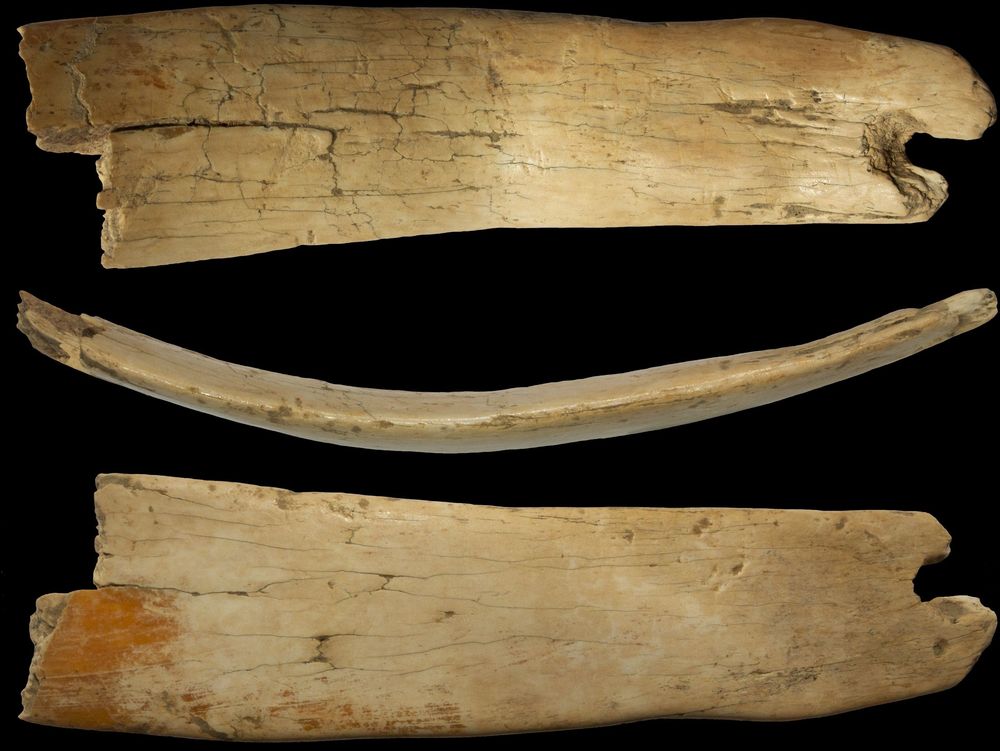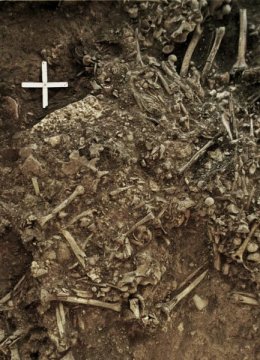Stonehenge Archaeologists Furious at Construction Crew Accused of ‘Smashing’ a 6,000-Year-Old Platform
Gold Coin Discovered in Slovenia
ČRNOMELJ, SLOVENIA—STA reports that archaeologists excavating one of 15 Celtic burials at the Pezdirčeva Njiva site, which is located in southeastern Slovenia, discovered a bronze belt adorned with a gold coin dating to the third century B.C. The coin bears images of the goddesses Nike and Athena and is thought to be a copy of a Greek coin known as an Alexander the Great stater. “A golden coin as such is a rare find in Slovenia,” said Lucija Grahek of the Academy of Sciences and Arts. “As far as I know, this is the third golden coin found at Slovenian sites, and as it seems, the oldest.” Some organic material making up the belt was also preserved. To read about another discovery in Slovenia, go to “Fixing Ancient Toothaches.”
Mammoth Tusk “Tiara” Discovered in Denisova Cave
 NOVOSIBIRSK, RUSSIA—According to a report in The Siberian Times, archaeologists have found a 50,000-year-old piece of worked woolly mammoth tusk in the southern gallery of Denisova Cave. Alexander Fedorchenko of the Novosibirsk Institute of Archaeology and Ethnography suggests the curved ivory object is a fragment of an ornament whose large size indicates it was worn by a Denisovan man. A cord would have been threaded through holes in either end of the piece and then tied around the wearer's head in order to keep his hair out of his eyes. There is evident wear and tear on the artifact, which was eventually discarded. Such ivory “tiaras,” as they are called, have been found in other parts of Siberia, but those decorated items were created between 20,000 and 28,000 years ago by modern humans. The Densiovan tiara suggests the tradition could be older than previously thought. For more, go to “Denisovan DNA.”
NOVOSIBIRSK, RUSSIA—According to a report in The Siberian Times, archaeologists have found a 50,000-year-old piece of worked woolly mammoth tusk in the southern gallery of Denisova Cave. Alexander Fedorchenko of the Novosibirsk Institute of Archaeology and Ethnography suggests the curved ivory object is a fragment of an ornament whose large size indicates it was worn by a Denisovan man. A cord would have been threaded through holes in either end of the piece and then tied around the wearer's head in order to keep his hair out of his eyes. There is evident wear and tear on the artifact, which was eventually discarded. Such ivory “tiaras,” as they are called, have been found in other parts of Siberia, but those decorated items were created between 20,000 and 28,000 years ago by modern humans. The Densiovan tiara suggests the tradition could be older than previously thought. For more, go to “Denisovan DNA.”
50,000 year old tiara made of woolly mammoth ivory found in world famous Denisova Cave
Online texts from Simo Parpola, The Correspondence of Assurbanipal, Part I: Letters from Assyria, Babylonia, and Vassal States
Ισλαμικά Θρησκευτικά και Κοσμικά Χειρόγραφα. Γραφή, διακόσμηση, ανάγνωση
New Strain of Plague Found in Neolithic Remains in Sweden
 MARSEILLE, FRANCE—Live Science reports that a new strain of Yersinia pestis, the bacteria that causes plague, has been identified in human remains from a Neolithic tomb in Sweden by a team of researchers led by biologist Nicolás Rascovan of Aix-Marseille University. The bacterial DNA came from the dental pulp of a 20-year-old woman who is thought to have died about 4,900 years ago from the deadly pneumonic form of the disease. Based upon comparisons with other strains of Yersinia pestis, Rascovan and his colleagues suggest this one diverged about 5,700 years ago, making it the oldest known strain of plague. It had been previously thought that plague first traveled to Europe from the Eurasian steppe as people migrated west and replaced European farmers, but the age of the plague strain found in Sweden suggests that European farmers may have already suffered from the infection and been in decline when the Eurasians arrived. Karl-Göran Sjögren of the University of Gothenburg said the presence of the plague in Sweden could reflect the growth of bigger settlements and poor sanitary conditions, use of wheeled transport, and increased contact among groups of people through trading networks in the Neolithic world, all of which may have helped spread the pathogens. The scientists have not yet found direct evidence of plague in any of these large Neolithic settlements, however. For more, go to “A Parisian Plague.”
MARSEILLE, FRANCE—Live Science reports that a new strain of Yersinia pestis, the bacteria that causes plague, has been identified in human remains from a Neolithic tomb in Sweden by a team of researchers led by biologist Nicolás Rascovan of Aix-Marseille University. The bacterial DNA came from the dental pulp of a 20-year-old woman who is thought to have died about 4,900 years ago from the deadly pneumonic form of the disease. Based upon comparisons with other strains of Yersinia pestis, Rascovan and his colleagues suggest this one diverged about 5,700 years ago, making it the oldest known strain of plague. It had been previously thought that plague first traveled to Europe from the Eurasian steppe as people migrated west and replaced European farmers, but the age of the plague strain found in Sweden suggests that European farmers may have already suffered from the infection and been in decline when the Eurasians arrived. Karl-Göran Sjögren of the University of Gothenburg said the presence of the plague in Sweden could reflect the growth of bigger settlements and poor sanitary conditions, use of wheeled transport, and increased contact among groups of people through trading networks in the Neolithic world, all of which may have helped spread the pathogens. The scientists have not yet found direct evidence of plague in any of these large Neolithic settlements, however. For more, go to “A Parisian Plague.”
4,000-year-old olive seeds unearthed in SE Turkey
[[ This is a content summary only. Visit my website for full links, other content, and more! ]]
Mantle neon illuminates Earth's formation
[[ This is a content summary only. Visit my website for full links, other content, and more! ]]
Strong growth in global CO2 emissions expected for 2018
[[ This is a content summary only. Visit my website for full links, other content, and more! ]]
Greenland ice sheet melt 'off the charts' compared with past four centuries
[[ This is a content summary only. Visit my website for full links, other content, and more! ]]
Scientists discover possible mantle mineral
[[ This is a content summary only. Visit my website for full links, other content, and more! ]]
Evolution of the inner ear: Insights from jawless fish
[[ This is a content summary only. Visit my website for full links, other content, and more! ]]
Soft tissue shows Jurassic ichthyosaur was warm-blooded, had blubber and camouflage
[[ This is a content summary only. Visit my website for full links, other content, and more! ]]
Sea invertebrate sheds light on evolution of human blood, immune systems
[[ This is a content summary only. Visit my website for full links, other content, and more! ]]
New study upends timeline of Iroquoian history
[[ This is a content summary only. Visit my website for full links, other content, and more! ]]
A detailed look at the microorganisms that colonize, and degrade, a 400-year-old painting
[[ This is a content summary only. Visit my website for full links, other content, and more! ]]
An exoplanet loses its atmosphere in the form of a tail
[[ This is a content summary only. Visit my website for full links, other content, and more! ]]
Unknown treasure trove of planets found hiding in dust
[[ This is a content summary only. Visit my website for full links, other content, and more! ]]
Russian scientists found new giant dinosaur
[[ This is a content summary only. Visit my website for full links, other content, and more! ]]







